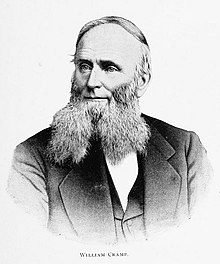


William Cramp, patriarch of the firm, circa 1870
| |
| Industry | Shipbuilding |
|---|---|
| Founded | 1830 (1830) |
| Founders | William Cramp |
| Defunct | 1947 (1947) |
| Headquarters | Philadelphia |
William Cramp & Sons Shipbuilding Company (also known as William Cramp & Sons Ship & Engine Building Company) was an American shipbuilding company based in Philadelphia, Pennsylvania, founded in 1830 by William Cramp. During its heyday in late 19th century, it was the preeminent American iron shipbuilder. [citation needed]
William Cramp was born in the Kensington district of Philadelphia in 1807. In 1855, his sons Charles Henry (born 1828)[1] and William C., became partners with their father. In 1872, his other sons Samuel H., Jacob C., and Theodore were taken into the firm. The company was incorporated under the name "The William Cramp and Sons' Iron Shipbuilding and Engineering Company."[2]
The pilot boat Thomas Howard was built by the Cramp shipyard in 1870 for the Delaware Bay & River pilots. She was one of the Philadelphia port's fastest pilot boats.[3]
In 1890 the company built the battleships USS Indiana and USS Massachusetts, armored cruiser USS New York, and protected cruiser USS Columbia. Three of these ships took a part in the defeat of the Spanish fleet in 1898 at Santiago de Cuba. The victory in this battle heralded America's emergence as a great power.[4] In 1896 Cramps united their artillery arm, the Driggs-Schroeder Ordnance Company, with its main competitor Hotchkiss Gun Company and a projectile manufacturer from Massachusetts into American Ordnance Company.[5] The American Shipping and Commercial Corporation bought the yard in 1919 but closed it in 1927[6] as fewer ships were ordered by the U.S. Navy after the adoption of the Naval Limitations Treaty in 1923.

In 1940, the Navy spent $22 million to reopen the yard as Cramp Shipbuilding to build cruisers and submarines. Cramp used the long slipways to construct two submarines at a time, with the intention of launching them simultaneously. However, the shipyard's submarine construction program was not especially successful, as poor management hindered the delivery of the boats.[7] The first delivery was made two years after keel laying, and fitting out was then done by Portsmouth Navy Yard. The best construction time for a submarine was 644 days.[8]
Cramp closed in 1947 and the site, on the Delaware River in Philadelphia's Port Richmond neighborhood, was turned into a residential estate in early 2020s.


Vessels built by the firm that are listed on the U.S. National Register of Historic Places include:
39°58′18″N 75°7′6″W / 39.97167°N 75.11833°W / 39.97167; -75.11833
Valencia maiden voyage May 1882.
{{cite book}}: |work= ignored (help)
![]() Media related to William Cramp & Sons at Wikimedia Commons
Media related to William Cramp & Sons at Wikimedia Commons
| International |
|
|---|---|
| National |
|
| Other |
|